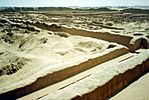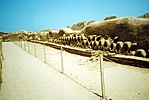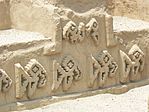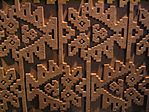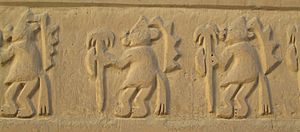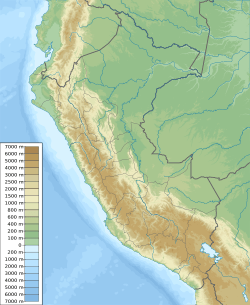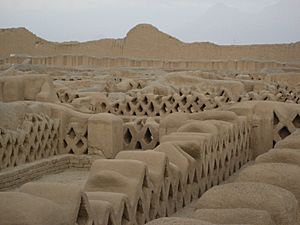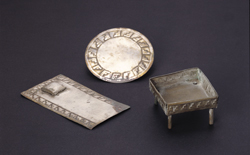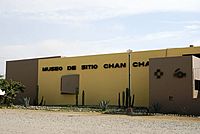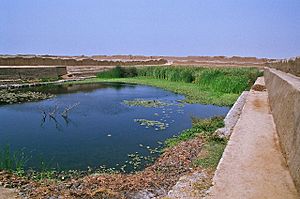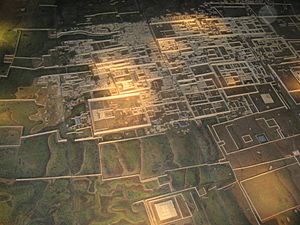Chan Chan facts for kids
|
From top: Chan Chan view, capital of Chimor, Chan Chan walls, Adobe detail at Chan Chan, Panel of warriors detail of wall, Pelican in Chan Chan, Chan Chan model, a wall in Chan Chan
|
|
| Location | La Libertad Region, Peru |
|---|---|
| Coordinates | 8°6′21″S 79°4′28″W / 8.10583°S 79.07444°W |
| History | |
| Founded | 850 |
| Cultures | Chimú culture |
| Official name | Chan Chan Archaeological Zone |
| Type | Cultural |
| Criteria | i, iii |
| Designated | 1986 (10th session) |
| Reference no. | 366 |
| Region | Latin America and the Caribbean |
| Endangered | 1986–present |
Chan Chan was once the biggest city in South America before Christopher Columbus arrived. It's an amazing archeological site in Peru, about 5 kilometers (3 miles) west of Trujillo, Peru.
This ancient city is located near the Moche Valley. It was the capital of the powerful Chimor empire from about 900 AD until 1470 AD. That's when the Inca Empire conquered them. The Chimor empire grew from the Chimú culture, which started around 900 AD along the Peruvian coast.
Chan Chan is in a very dry desert area in northern Peru. Since it hardly ever rains, the city got its fresh water from rivers flowing down from the Andes mountains. The Chimú people built clever irrigation systems to control this water. This allowed them to grow crops and support a large city.
The city of Chan Chan covered about 20 square kilometers (7.7 square miles). Its main part, about 6 square kilometers (2.3 square miles), had impressive ciudadelas. These were huge, fancy buildings with open spaces, storage rooms, and special burial places for the royal family. The best houses for ordinary people were called SIARs, which often served as workshops for artisans.
Contents
What Does "Chan Chan" Mean?
The name "Chan Chan" probably comes from an old language called Quingnam. "Jiang" or "Chang" meant "Sun." So, "Chan-Chan" could mean "Sun-Sun." People think it might really mean "Great Sun" or "Splendid Sun." This is because repeating a word in Quingnam often gave it a new, stronger meaning.
Another idea is that the name comes from "Shian" or "Sian." "Shi" meant "Moon" and "An" meant "house." So, it could mean "House of the Moon." This would show that the Moon was a very important god to the people.
A Look at Chan Chan's History
Historians believe the Chimú culture built Chan Chan around 850 AD. It became the capital city of the Chimor empire. At its peak, between 40,000 and 60,000 people lived there!
Around 1470 AD, the Inca conquered the Chimú. After this, Chan Chan started to decline. The Inca had a system where they moved people from conquered lands to other areas. This meant many Chimú people were moved away from Chan Chan.
Then, in 1535 AD, Francisco Pizarro founded the Spanish city of Trujillo nearby. This made Chan Chan even less important. Even though it was no longer a busy capital, Chan Chan was known for its great wealth. Because of this, the Spanish looted many of its treasures. Records from the 1500s show that a huge amount of gold was taken from one burial tomb!
In 1969, archaeologists Michael Moseley and Carol J. Mackey started digging at Chan Chan. Today, this important work continues under the Peruvian Instituto Nacional de Cultura.
Protecting Chan Chan
In 1986, UNESCO named Chan Chan a World Heritage Site. This means it's a very important place for everyone in the world. However, they also put it on the List of World Heritage in Danger. This was because the site needed a lot of help to be preserved.
Experts recommended protecting, restoring, and managing the site carefully. They also said that no more digging should happen without plans to save what was found. People also needed to stop stealing from the site.
Many groups have worked together to protect Chan Chan. They are trying to cover the buildings to shield them from rain. They are also building new drainage systems to remove rainwater quickly. Chan Chan has been on the "in danger" list since 1986. Since 2000, new safety plans have been put in place. These include keeping detailed records, managing the site for visitors, and having emergency plans.
Exploring the Archaeological Site
The Chan Chan archaeological site covers about 20 square kilometers (7.7 square miles). It is the largest adobe (mud brick) city in the Americas and the second largest in the world!
The city has many walled compounds, which were like palaces. Here are some of their names and what they mean:
| Old name | Current name | Meaning |
|---|---|---|
| Chayhuac | Chayhuac An or Quixmic An | Chayhuac House or Beginning House |
| Uhle | Xllangchic An | East House or Sunrise House |
| Laberinto | Fechech An | West House or Sunset House |
| Gran Chimú | Utzh An | Big House |
| Squier | Fochic An | North House |
| Velarde | Ñing An | Sea House |
| Bandelier | Ñain An | Birds House |
| Tschudi | Nik An | Center House |
| Rivero | Chol An | New House or Final House |
| Tello | Tsuts An | Small House |
The Nik An Compound (Tschudi)
The "Nik An" compound (also called Tschudi) is a great example of how important water and the sea were to the Chimú culture. Its walls have carvings of fish pointing north and south. This might show the two ocean currents that affect the Peruvian coast: the cold Humboldt Current from the south and the warm El Niño current from the north. You can also see waves, fishing nets, pelicans, and sea creatures like sea lions and otters.
This society was ruled by powerful leaders called Chimucapac. They needed strict control over water and protection from outside threats. The "Nik An" complex had only one entrance and tall walls, up to twelve meters (40 feet) high. The walls were wider at the bottom (five meters) than at the top (one meter). This design helped them stand strong during earthquakes, which are common on this coast.
Buildings of Chan Chan
Chan Chan had many types of buildings, though many have been destroyed over time. These included temples, homes, water reservoirs, and even special platforms for funerals. Many buildings had designs inspired by the ocean, like fish, birds, and waves. The Chimú were very clever in how they used space, building structures mostly in rectangular or square shapes.
The city had 10 large citadels, but only 4 have been fully explored. This suggests that Chan Chan had 10 different rulers over time. The Chimú society had a clear class system, with rulers and gods at the top, and servants at the bottom. A citadel was like a palace, often 40 feet tall, with beautiful decorations and only one entrance. These grand buildings were made for the "gods or rulers."
People and Workers
Chan Chan was home to many different kinds of people and workers. Their society had different levels of importance. Rulers and priests were at the top, followed by nobles, farmers, fishers, traders, and servants. The city had many skilled craftspeople who made beautiful fabrics, pots, and ceramics.
The Chimú people believed that the sun created three eggs. A gold egg was for the ruler and important people. A silver egg was for the wives of the rulers. And a copper egg was for everyone else. The elite, or important people, lived in the grand citadels. Most other people lived in smaller homes that also served as their workshops.
Even though they were an agriculture-based city, the Chimú were famous for their amazing pottery and textiles. They created many beautiful pieces of art, some of which we can still see today.
Religion and Culture
Of the 10 citadels in Chan Chan, Tschudi (also called Nik An) is the only one tourists can visit. It's thought that Tschudi was built to honor the Chimú sea god, "Ni." This is because of the many ocean-related carvings and designs inside the building. There was a pond in the middle of the building used for religious ceremonies, to celebrate fertility, and to worship water. The Chimú people greatly worshipped the ocean because they lived right next to the Pacific Ocean and got most of their food from it. They also depended heavily on their irrigation system, so they believed it was important to worship gods connected to water and the sea.
The people of Chan Chan supposedly spoke a language called "Mochica." Sadly, once the Inca took over, this language disappeared and is now extinct. Very little was written down about the Mochica language, so we don't know what it sounded like. The Chimú people didn't have a writing system to record their language or to write down building plans or measurements.
However, if you look at photos of Chan Chan, you'll notice how all the buildings are built in a clear order with space between them. Even without a written system, it's possible they kept records using something like the Inca's "Khipus." Khipus were detailed records made with knotted cords. They could also be used to communicate information.
Architecture of Chan Chan
The city has ten walled ciudadelas (palaces). These grand buildings held ceremonial rooms, burial places, temples, water reservoirs, and homes for the Chimú kings. Besides the ciudadelas, Chan Chan also had courts called audiencias, small irregular rooms (SIARs), and mounds called huacas. We know these buildings were important because many ancient pottery pieces found at Chan Chan show images that look like the audiencias. This tells us that architecture was very important to the Chimú people. Also, building such huge structures meant there was a large workforce available. This supports the idea that Chan Chan had a strict social system, where the working class likely built these amazing buildings.
Chan Chan is shaped like a triangle and is surrounded by walls that are 50 to 60 feet tall. There are no openings on the north side because the north-facing walls get the most sun. These walls helped block wind and absorb sunlight, which was useful in a foggy area. The tallest walls protected the city from strong winds coming from the coast. The walls are made of adobe bricks covered with a smooth surface. Intricate designs are carved into this surface. The carvings show realistic images of birds, fish, and small mammals, as well as more artistic, simplified versions of the same subjects. You can see crabs, turtles, and nets for catching sea creatures like Spondylus shells. Unlike most ancient ruins in Peru, Chan Chan is very close to the Pacific Ocean.
Water for the City
At first, the city got its water from wells that were about 15 meters (50 feet) deep. To grow more food, the Chimú built a huge network of canals. These canals brought water from the Moche River to the farmland around the city. With these canals, the city could grow much larger.
However, a big flood around 1100 CE destroyed many canals to the north. This event was a major reason why the Chimú Culture started to focus more on trading for resources instead of just farming. Chan Chan's irrigation systems were also a key reason why the Incas were able to conquer them. The Incas cut off the long canals that brought water from the Moche Valley River to Chan Chan. This left the Chimú's crops to die from lack of water.
Threats to Chan Chan
The ancient structures of Chan Chan are constantly threatened by erosion. This happens because of changing weather patterns, like heavy rains, floods, and strong winds. The city is especially at risk from storms caused by El Niño. El Niño brings much more rain and flooding to the Peruvian coast.
Chan Chan is the largest mud city in the world, and its fragile material is a big concern. The heavy rains from El Niño damage the bases of Chan Chan's buildings. More rain also means more humidity. When humidity builds up in the bases of these structures, salt can contaminate them, and plants can start to grow. Both of these things further damage the buildings. Global warming might make these problems even worse, as some studies suggest it could lead to more rainfall.
Recent Efforts to Save Chan Chan
The archaeological site of Chan Chan is always in danger of being ruined by weather. Many archaeologists and experts are working to study and protect the buildings there. They use special methods that are both fast and accurate to document the site. For example, they use unmanned aerial vehicles (UAVs), which are like drones. These drones have small parts and light cameras. They can create digital maps, detailed photos, and even 3D virtual models of the site. Sometimes, protective covers over the adobe buildings can make it a bit tricky for the drones to get good images.
These modern methods don't harm the ancient structures. They also allow archaeologists to have virtual copies of the site for the future. As technology gets better, these models will become even more useful for studying Chan Chan.
Since 2002, an Italian team has been working with local archaeologists at Chan Chan. In 2017, Roberto Pierdicca from an Italian university used drones to map parts of the site. The newest map before this was made by Harvard University in 1974. Pierdicca's team mapped the Tschudi Palace area. They used a drone with a high-resolution camera to take many pictures from above and at angles. They used these photos to create a detailed 3D model. This model helps experts understand the site better and plan for its protection.
Between 2016 and 2022, another international project focused on the Huaca Arco Iris. This is the largest adobe monument in South America and one of the first structures built at Chan Chan. It's believed to have been a ceremonial burial platform. In 1963, some restoration work was done on its walls. Creating 3D models of the Huaca Arco Iris is a big part of the Italian team's work in Peru. They use special cameras and software to build detailed 3D models of the walls and carvings. This helps them monitor the site and ensure its long-term survival.
Buildings made from clay and straw mud are some of the oldest on Earth. This building method is very flexible, as you can make bricks of any size to build any structure. About 180 UNESCO World Heritage Sites are built with mud to some extent. In 1994, the Getty Center started a course on mud architecture and how to preserve it, right at the Museum of Chan Chan.
See also
 In Spanish: Chan Chan para niños
In Spanish: Chan Chan para niños
- Moche Valley
- Chimú Culture
- Inka empire
- Andes mountains
- Irrigation
- Erosion
- World Heritage Sites in Danger
- Spondylus
- Peru


